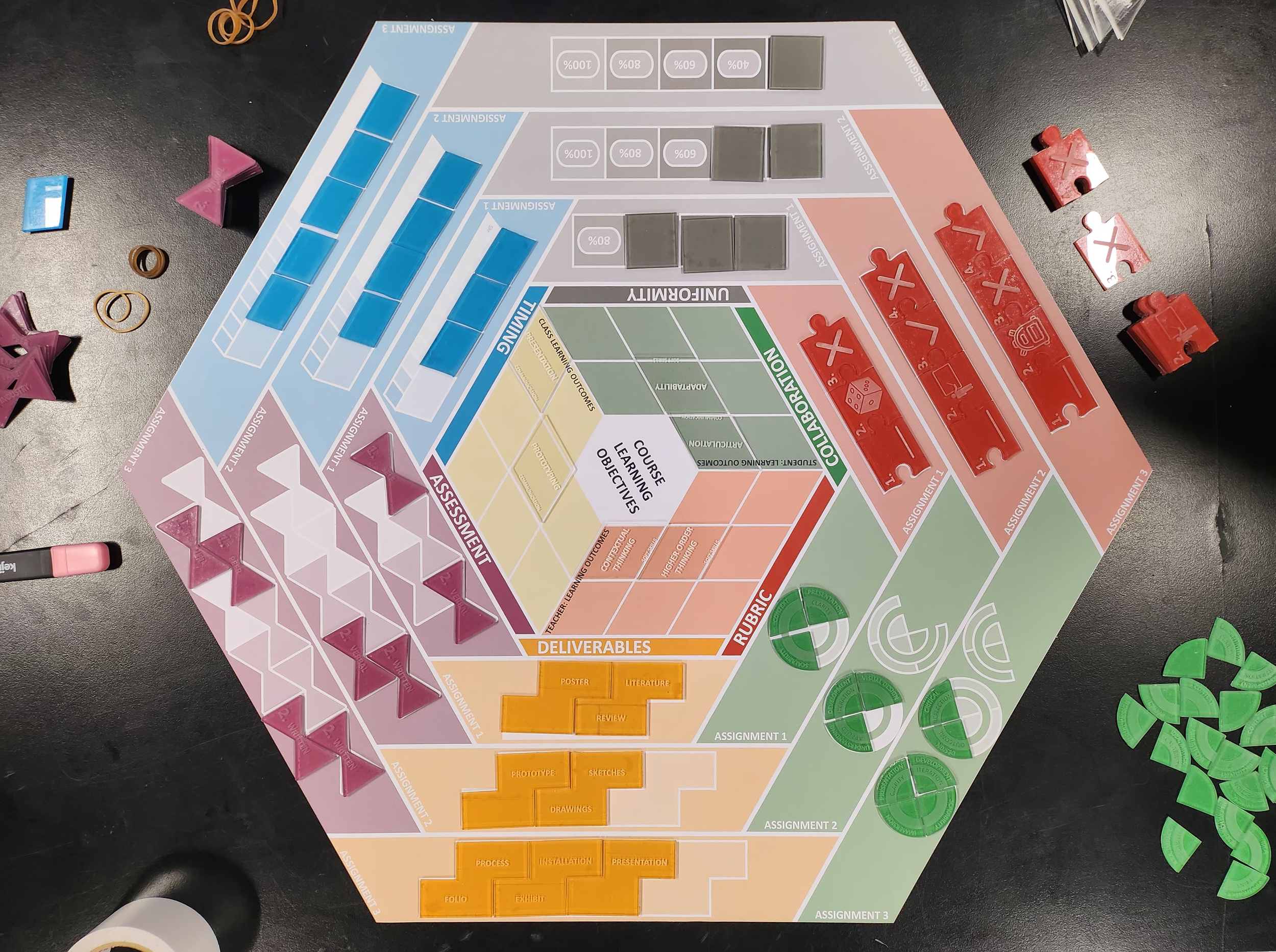
Design Course Planner
A semester course planning aid made for sessional and casual design educators. The planner is designed to improve engagement and immersion for students, and give clarity to lecturers on their course learning objectives and assignment structure. Using the planner encourages autodidactic learning and pivots control over the course towards the students.
The planner consists of a map printed on tarp and a set of acrylic “puzzle” pieces.
The planner is divided into six sections across three assignments, plus a central area for overarching course objectives.
The “puzzle” pieces have different meanings for each of the seven areas, and correspond with how the students and educator want assignments and course learning objectives to be delivered.
Educators and students collaboratively work on the planner, an activity which promotes engagement with the course objectives and with the lecturer(s) at an early stage, alongside enhancing control and satisfaction for students. The planner gives students the opportunity to design and shape how their course will run and what each student will be able to gain from undertaking each assignment and in the completion of the course.
-
Assessment determines by who, and how, students are assessed. Are they assessed by peers? self-assessed? by an industry or academic panel? How do they receive feedback? Written? Verbal? Percentage or grade?
-
Deliverables dictates the medium of the assignment. What tangible deliverables will the assignment ask for? Poster, video, presentation, prototype, style guide, wireframe, report, et cetera.
-
Rubric asks what will be assessed - visual design, presentation clarity, depth of research, design outcomes, stakeholder consideration, et cetera.
-
This section asks how many members assignments will have, who will assign those members, will there be roles (CEO, CFO, CDO, etc.), and will there be fields (graphic designer, UI/UX designer, design researcher, etc.).
-
This section asks how similar deliverables will be. Ranging from 0% (No uniformity required, assignment deliverables can take any form) to 100% (templates given, where information is required to be backfilled).
-
How long will each assignment run for, and how many hours do the students want to dedicate to those assignments in each week? Given there are only so many weeks in the semester, this section leaves decisions around how much they want to get out of the course in their own hands.
-
Course Learning Objectives that the teacher wants for the students. For sessional staff, these learning objectives are typically given to them by the professor or course coordinator in charge of the course.
-
Course Learning Objectives that the generalised class want to learn from, or get out of, the course. These may be very specific or much broader objectives, dependent on the type of course and the students' preconceptions around the class.
-
Unique Course Learning Objectives held by one, or very few, students. These students may have different expectation or preconceptions about the course, and where possible should try to be fulfilled.

The Design Course Planner was created around a multifaceted case-study research project conducted at RMIT University. The case study utilised interviews and co-design with staff and students, user journey mapping, service blueprints and applied pedagogical theory to create the course planning framework.
The planner is ideal for casual and sessional design staff looking to streamline their course planning groundwork without sacrificing curriculum efficacy and increasing student satisfaction. It focuses on contextualisation of the course field for students, improving engagement and immersion while making classes more reactive and dynamic in their design outcomes.
More information about the research and development can be explored below.

RESEARCH
Case Study
A research case study completed over the course of 10 weeks examining the experiences of students and staff within RMIT’s prestigious Bachelor’s of Industrial Design (Honours) program. Using interviews, personas, journey maps, and blueprints amongst other service design research techniques has allowed us to identify and appropriately respond to problem areas within the program.
Examination of the RMIT Bachelor’s of Industrial Design (Honours) core unit structure and learning objectives
This course layout visualisation was created to summarise implementation of course objectives and skills within RMIT’s Industrial Design Bachelors.
The poster acts as a research task within the case study that identifies on a macro level the learning objectives for the program.
The poster also identifies the basic assignment structures used in the course.
This facilitates a holistic look at what RMIT values within their industrial design course, and how they are applying those concepts.
Personas and Journey Maps; Interviews were conducted to create personas, then a User Journey and Persona Journey map are constructed around these characters.
The User Journey Map and the Persona Journey Map are tools constructed to visualise emotional and objective outcomes around satisfaction, expectations, class choice, skills and grievances.
The maps make conducted research tangible and presentable to a wider audience, and work to summarise backstage data.
Personas are based on generalised characters formed through research. They have goals and preferences, and allow us to extrapolate information by embodying a persona and acting out their experiences as they undergo the course.
A service blueprint was created based on the information gathered from the assignment layout, personas, and user journey map. This served to foundation the requirements of the Course Planner
The Service Blueprint was constructed to visualise every touchpoint in the Industrial Design course structure.
The service blueprint spans from pre-enrollment to post-semester, exploring categories broken down into three sections: Classroom, Frontstage, and Backstage.
COURSE PLANNER - DEVELOPMENT
This section shows a wealth of developmental information in very few words - flick your way through our development process for a better understanding of how this project came together.











The Design Course Planner and all research involved was conducted and created by myself (James Fernihough), Mesa Sobhe and Oscar Howard.
We encourage you to get in contact for more information!






